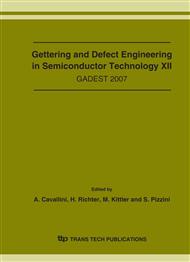[1]
K. Tempelhoff, F. Spiegelberg, R. Gleichmann, D. Wruck. Phys. Stat. Sol. (a). Vol. 56 (1979), pp.213-223.
DOI: 10.1002/pssa.2210560123
Google Scholar
[2]
B. Pajot, H.J. Stein, B. Cales, C. J. Naud. Electrochem. Soc. Vol. 132 (1985), pp.3034-3037.
DOI: 10.1149/1.2113717
Google Scholar
[3]
K. Nakai, Y. Inoue, H. Yokota, et al. J. Appl. Phys. Vol. 89 (2001), pp.4301-4309.
Google Scholar
[4]
A.A. Efremov, V.G. Litovchenko, A.V. Saricov, H. Richter, V. Akhmetov. Solid St. Phenom. Vol. 95 -96 (2004), pp.405-408.
Google Scholar
[5]
I.P. Lisovskyy, V.G. Litovchenko, V.B. Lozinskii et al. Thin Solid Films. Vol. 213 (1992), pp.164-169.
Google Scholar
[6]
I.P. Lisovskyy, V.G. Litovchenko, V.B. Lozinskii et al. J. Non-Cryst. Solids. Vol. 187 (1995), pp.91-95.
Google Scholar
[7]
I.P. Lisovskyy. Ukr. J. phys. Vol. 42 (1997), pp.1260-1265.
Google Scholar
[8]
J.G. Vinter, A. Davis, M.R. Saunders. J. J. Comput. -Aided Mol. Des., Vol. 1 (1987), pp.31-51.
Google Scholar
[9]
V.T. Bublikh, K.D. Scherbachev. Crystallography. Vol. 42 (1997), pp.326-330.
Google Scholar
[10]
V.A. Khrivoglaz: Diffraction of X-rays and thermal neutrons in non-ideal crystals (Naukova Dumka, Kiev 1983).
Google Scholar
[11]
V.T. Bublikh, K.D. Scherbachev. Crystallography . Vol. 39 (1994), pp.1105-1111 (in Russian).
Google Scholar
[12]
V.P. Kladko, L.I. Datsenko, J. Bak-Misiuk, S.I. Olikhovskii, V.F. Machulin, I.V. Prokopenko, V.B. Molodkin, Z.V. Maksimenko. J. Phys. D: Appl. Phys. Vol. 34 (2001), p. A87-A92.
DOI: 10.1088/0022-3727/34/10a/318
Google Scholar
[13]
K. Ravey: Defects and impurities in semiconductor silicon (Мir, Moscow 1984).
Google Scholar
[14]
V.G. Litovchenko. Semiconductor technique and microelectronics. Vol. 33 (1981), pp.3-17.
Google Scholar
[15]
A. Usami, K. Okura, T. J. Maki. Phys. D: Appl. Phys., Vol. 10 (1977), p.63.
Google Scholar
[16]
I.M. Greskov, B.V. Smirnov, S.P. Solovjov, et al Semiconductors. Vol. 12 (1978), pp.1879-1882.
Google Scholar
[17]
A. Szekeres , A. Paneva, S. Alexandrova , I. Lisovskyy , V.G. Litovchenko, D. Mazunov. Vacuum. Vol. 69 (2003), pp.355-360.
DOI: 10.1016/s0042-207x(02)00358-5
Google Scholar
[18]
A.G. Revesz. Phys. Stat. Sol. Vol. 57 (1980), pp.235-243.
Google Scholar
[19]
J. Vanhellemont and C. Claeys. Appl. Phys. Vol. 62 (1987), pp.3960-3971.
Google Scholar


